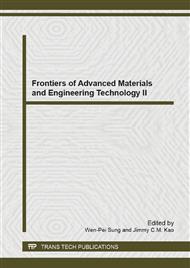p.99
p.103
p.107
p.111
p.115
p.119
p.123
p.127
p.131
Effect of Porosity on Mechanical Property and Acoustic Emission Signals of Composite Materials
Abstract:
In order to achieve the effect of porosity on the mechanical property and acoustic emission (AE) signals of composite materials with mode I delamination, unidirectional tensile tests and real-time AE monitoring of high property and low property composites were conducted. The results show that the porosity of composite materials made a detrimental effect on the mechanical properties. As the load increases to an inflection point, the slope of the curve becomes smaller. And the slope of the high porosity specimen is lower than that of the other one. With the increase of the porosity of composite material, the failure load and tensile strength decrease. AE monitoring data show that different porosity materials lead to different evolution process of the delamination. And the corresponding AE amplitude distribution, relative energy signals are also different. Different from high porosity composites, low porosity composites generated unstable expansion at the inflection point of the load curve in the stretching process. And the highest amplitude and relative energy were obtained at the inflection point.
Info:
Periodical:
Pages:
115-118
Citation:
Online since:
April 2014
Authors:
Keywords:
Price:
Сopyright:
© 2014 Trans Tech Publications Ltd. All Rights Reserved
Share:
Citation:


